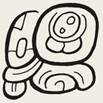![]()


![]()
![]()
K&H.p33.r3.c1 K&H.p33.r3.c2 JM.p109.#2 JM.p109.#3 AT-YT2021-lecture11.t0:28:50
ja.yi u.<ja:yi> ja:yi ja yi u.<ja:yi> yu.<k’i:bi>



Martin-HftPP.p67.pdfp4.c2.fig16 AT-YT2021-lecture11.t0:29:11 AT-YT2021-lecture11.t0:29:11
CLK Structure Sub1-4 EsE-LtS2 caption K1398 PSS-7
AJ ja:yi u.<ja:yi> u ja.ya



mayavase.com = Martin-HftPP.p67.pdfp4.c2.fig17a mayavase.com
K4333 #1 K4542
u.<ja:yi> u.<ja:yi>
· Commonly found in the PSS of ceramic vases.
· CLK Structure Sub1-4 EsE-LtS2 is also shown in AT-YT2021-lecture11.t0:29:11. CLK Structure Sub1-4 is the building with many murals depicting scenes from a marketplace – with the sellers of many goods labelled in glyphs as such.
· K&H.p33.r3.c2 has the u on the right side, but reads it first. This appears to be a “mirror image” inscription, as the “eyeballs” are facing right instead of the usual left.
· Meaning – there appears to be uncertainty about the specific meaning:
o Possibility 1 – used to indicate “fine, more delicate vessels”:
§ Dütting&Johnson-TRRTNSAGL.p176 (1993) translates K1398 PSS-6 PSS 7 u ja-ya è jaay as “his thin-walled vessel”.
§ AT-E1168-lecture11.t0:16:01-0:17:31 glosses K4333 glyph-block #1 u.<ja:yi> è ujaay as “his fine clay vessel”.
§ AT-YT2021-lecture11.t0:25:39 glosses K1398 PSS-6 PSS-7 u ja-ya è ujay as “his fine vessel”.
§ AT-YT2021-lecture11.t0:28:50: this is of course the usual way to write ja-yi è jaay; and that’s the generic term for “fine vessels” which have thin walls […].
§ AT-YT2021-lecture11.t0:29:11 glosses K1398 PSS-7 ja-ya è jay as “fine clay vessel”.
o Possibility 2 – not related to delicateness:
§ K&H.p34-35 (2020):
· ujaay / ujay. This vessel type refers to bowls with rounded or flat bases and more rarely to short, straight-walled bowls. It has been suggested that this term is related to the cognate root jay for “thin” in Yukatek, Ch’olan, and Tzotzil (MacLeod 1990: 363). However, this interpretation has syntactical problems since it frequently includes a possessive pronominal prefix indicating that it must function as a noun rather than an adjective. Indeed, a possessed adjective such as “his/her thin” is awkward and hardly resolved by this interpretation. In contrast, MacLeod (1990: 363-364) has pointed to productive entries such as “tortilla gourd” (Laughlin 1988: 148), “tub”, “basin” and “plate” in Colonial Tzotzil (Laughlin 1988: 207), which in this context fulfil not only the syntactical requirements but also expected semantic values. // Generally, vessels attributed the designation jaay are bowl-shaped and thus bear overall similarity to halved gourds, the probable origin of the term. Nonetheless, few existing cognates exist suggesting that the term fell into disuse after the Classic period. Despite the paucity of relevant linguistic data, Alfonso Lacadena found jay for “tazón de barro” (“clay bowl”) in Tzotzil (personal communication 2002) suggesting that once ceramic vessels came to replace the original gourd counterparts the term was preserved nonetheless. Based on these analyses the term *jaay thus seems to be a descriptive rather than a functional designation, for “bowls” and originally for “gourd-shaped bowls.”
· jaay yuki’b(iil) / jay yuk’ib(iil). This vessel type refers to vases and bowls, although the latter predominate, as do rounded bases. This vessel type designation is represented by the compounding of the two terms previously reviewed. In this context, were the (possessive) pronominal affix absent on the second term and present on the first, the interpretation of “his/her thin drinking implement” would be supported syntactically. However, these circumstances are not present suggesting that the adjectival interpretation of jaay should be abandoned.
§ Martin-HftPP.p67.pdfp4.c1.para1.l+5 (2012): This word is familiar from dedicatory phrases on ceramic vessels. Many texts on Chochola-style incised cylinder vases, for example, use the possessed form ujaay “his/her jaay” to introduce the names of their owners (Grube 1990:322) (Figure 17a). Jaay has been lost from most Mayan languages but survives in Mopan (Ulrich and Ulrich 1976) and in Tzotzil (Delgaty 1964) as “clay bowl, tecomate”.
§ StuartEtAl-GoP.pdfp18.para3 (2005): The word jay appears in modern lowland languages as an adjective meaning “thin”, which have led many to wonder if its use on Classic vessels is to highlight the fine thin walls of cylinder bowls. But the role of u-ja-yi glyph as a stand-alone noun would argue against this particular interpretation. // A welcome resolution to the meaning of the jaay glyph came in 1995, when Alfonso Lacadena noticed the following straightforward entry in Ulrich and Ulrich’s Mopan vocabulary: jaay, “tazon de barro” (clay cup). Obviously, this is our answer. When paired with the y-uk’ib label, the inscription reiterates “his clay vessel, his drinking cup…”
· Pronunciation:
o Note the synharmonic spelling ja-ya in K1398 PSS-7; AT-YT2021-lecture11.t0:25:39-26:15 (specifically 0:25:45): … in fact, it is written as u-ja [with] the full head of the Moon Goddess – ya – it’s one of those late synharmonic spellings – the usual sequence is ja-yi and here it is ja-ya – the vowel length [has] basically collapsed by that time, and the scribe is no longer representing it.
o K&H.p34.fn42: ujaay / ujay. The difference in the value of the vowel in the terms jaay and jay is a regional one. In western Yucatan and Northern Campeche, Mexico the term jaay prevailed in exclusivity. While the same term is present in the central Lowlands, jay is occasionally represented indicating regional linguistic variation. The meaning of the term appears to have been the same despite these phonological changes.